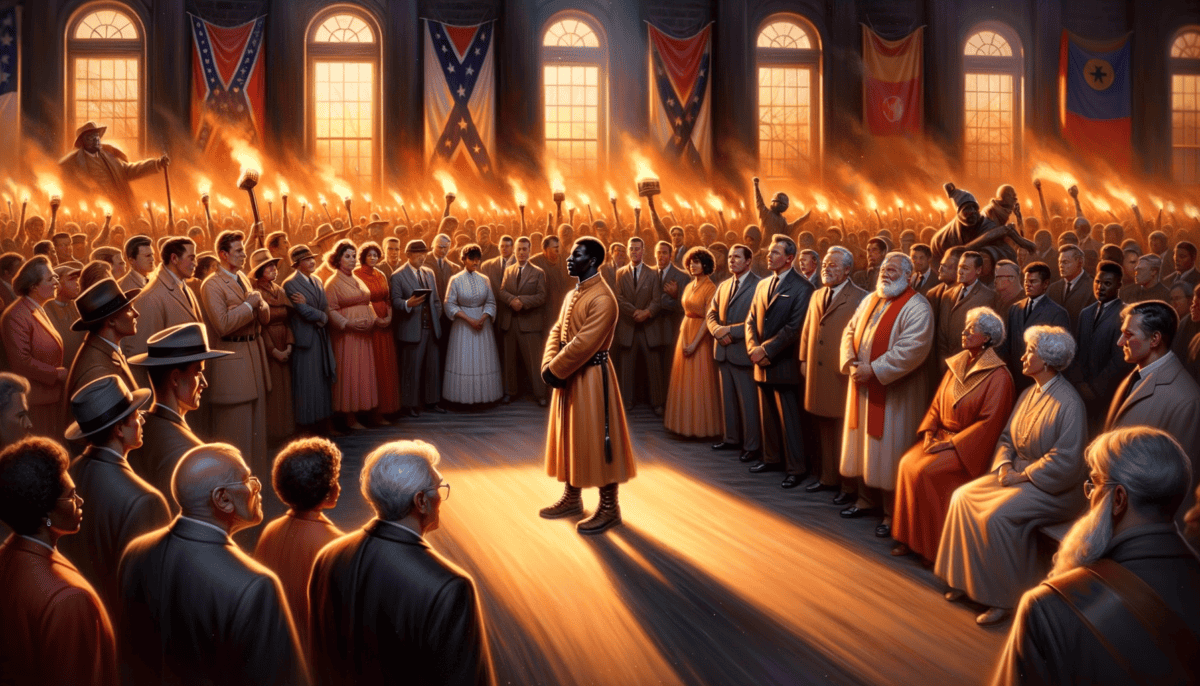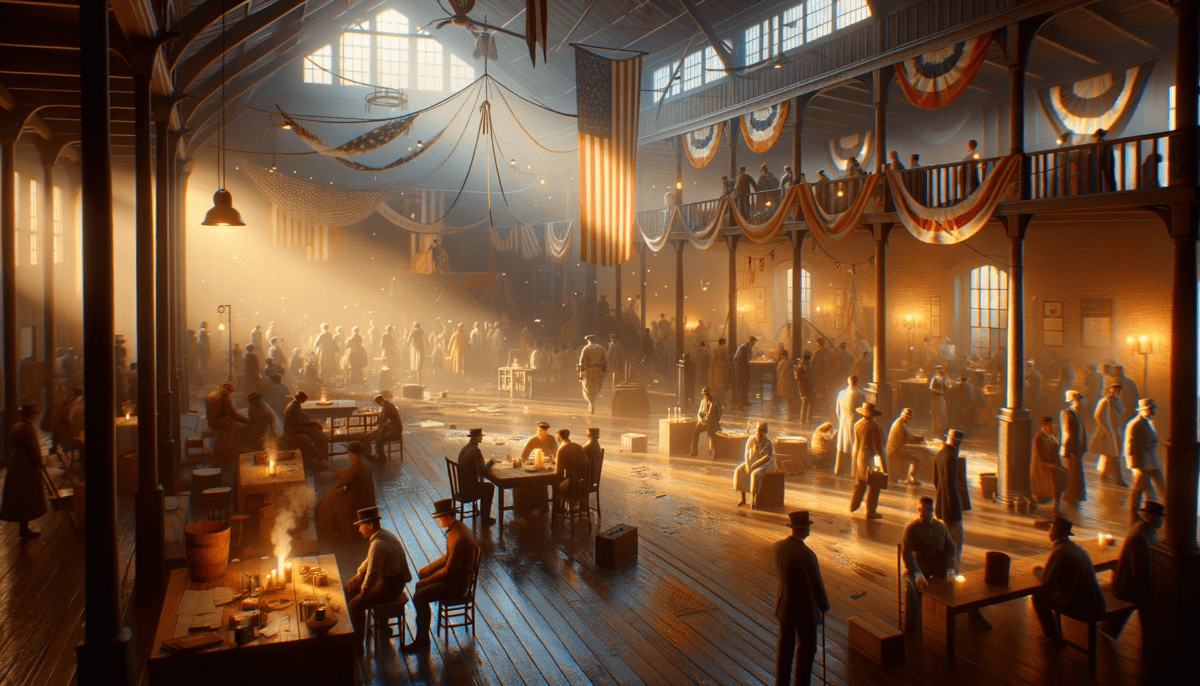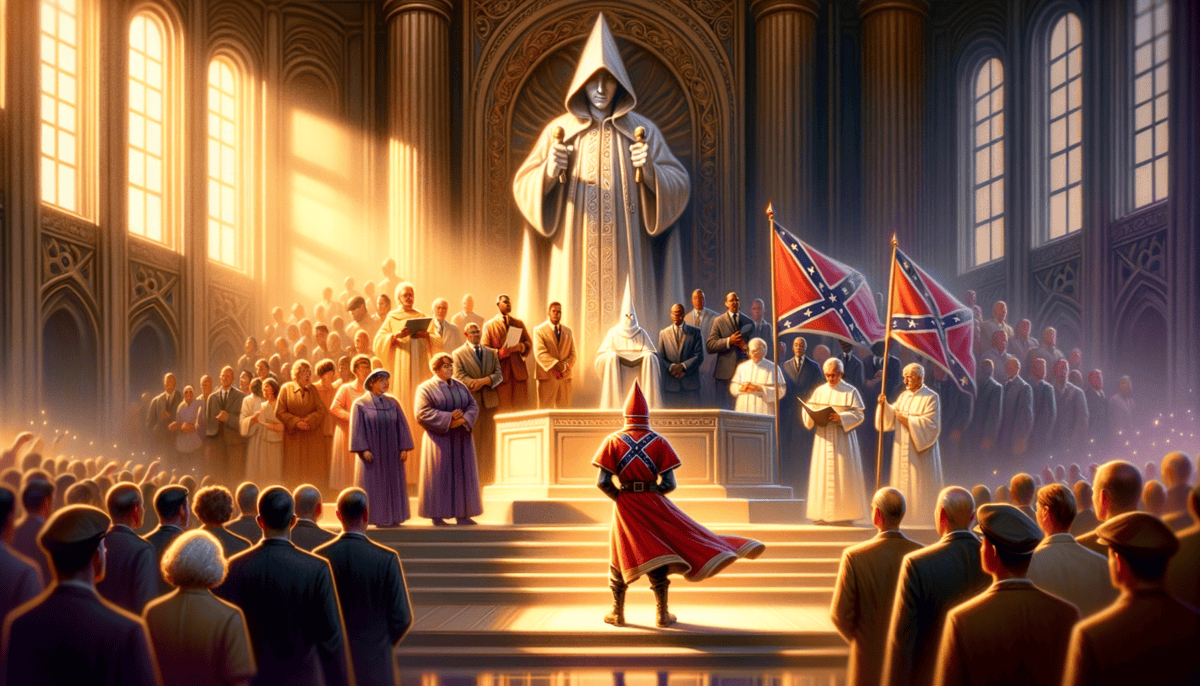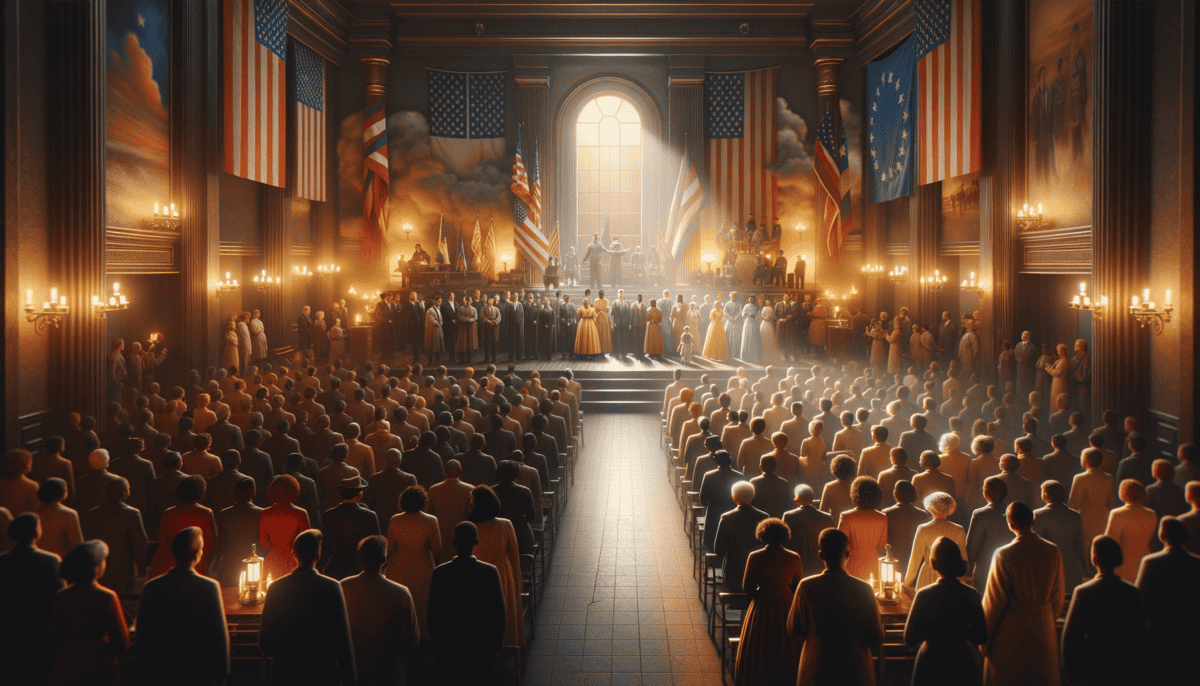Seeds of Division
Back in 1865, the Civil War had just ended. The South had lost, and many people were sad and angry. Some soldiers who fought for the South didn’t know what to do next.
The Civil War was fought between the North and South of America from 1861 to 1865.
One night in Tennessee, six men met in a small room. They were all former soldiers who had lost the war. The room was lit by just one candle, making shadows dance on the walls.
“We need to do something,” said Nathan Bedford Forrest, their leader. “Things are changing too fast.” He wasn’t happy that Black people were now free and could vote.
These men started a secret club. They called it the Ku Klux Klan, or KKK for short. At first, it was like other clubs where men would meet and talk. But soon, it became something much scarier.
They wore white sheets and hoods to hide who they were. Many people in the South joined their group. They would ride horses at night, carrying torches and trying to frighten people.
“The KKK grew very quickly,” says Dr. Sarah Thompson, who studies this part of history. “By 1868, they were in many Southern states.”
Black Americans had just gotten their freedom, and many good things were happening:
- They could vote for the first time
- Some became teachers and leaders
- New schools opened for Black children
- Black people could own businesses
But the KKK didn’t like these changes. They wanted things to stay like they were before the war. They tried to stop progress by being mean and scary.
Some brave people stood up to the KKK. They weren’t going to let fear stop them from having better lives. Black communities came together to protect each other. They built churches and schools, even when it was dangerous.
The president at the time, Ulysses S. Grant, didn’t like what the KKK was doing. He made new laws to stop them. These laws helped for a while, but the KKK didn’t go away completely.
Many white people in the South joined the KKK because they were scared of change. They didn’t understand that everyone deserves to be treated fairly. The group kept growing, spreading their mean ideas to more places.
As the years went by, more and more people started speaking up against the KKK’s meanness. They knew that treating people badly because of their skin color was wrong. This was just the beginning of a long fight for equal rights that would last many years.
Rise of Hatred
The year was 1920. America was changing fast. More people were moving to cities. New inventions like cars and radios were everywhere. But with all these changes, some people got scared and angry.
In the 1920s, the KKK grew bigger than ever before. Almost 5 million people joined!
A man named William Simmons saw a way to make money from people’s fear. He started telling stories about how the “old KKK” was great. He put ads in newspapers and made speeches. Many people listened.
The KKK wasn’t just mean to Black people anymore. They started being mean to:
- People who came from other countries
- People who went to Catholic churches
- Jewish families
- Anyone who seemed different
Sarah was a little Jewish girl in Atlanta. One night, she saw men in white robes marching down her street. “Mama,” she whispered, “why are they doing this?” Her mother pulled her away from the window. “Some people are afraid of what they don’t understand, sweetie.”
“The KKK tried to seem normal and nice to some people,” explains historian Tom Brown. “They had picnics and parades. But at night, they did scary things.”
They made up silly rules about who could join:
– Had to be white
– Had to be born in America
– Had to be Christian
But not everyone liked what the KKK was doing. Newspapers started writing stories about their mean acts. A reporter named Elizabeth Adams was very brave. She wrote about KKK secrets in her newspaper.
By 1925, people started learning more truth about the KKK. They found out that leaders were stealing money. Many members quit when they learned this. Good people didn’t want to be part of such a mean group.
In schools, kids from different backgrounds sat together. They played together at recess. They showed that the KKK’s ideas about hate were wrong. Children knew that being different was okay.
By the end of the 1920s, the KKK wasn’t as strong. More people were speaking up against them. Communities came together to say no to hate. Churches, schools, and neighbors worked together to make things better.
But the fight wasn’t over. Some people still believed in the KKK’s mean ideas. The next big challenge would come when brave people started standing up for their rights in new ways.
Standing Together
The sun rose over Birmingham, Alabama in 1930. A young girl named Ruby watched her father leave for work. She knew things weren’t right in their town. But change was coming. Brave people were starting to speak up.
Good people began working together to stop the mean KKK. They formed groups to help each other stay safe.
A new group called the NAACP helped people fight back using laws, not violence. They had smart lawyers who went to court. One lawyer, Thurgood Marshall, became very famous for helping people.
“We don’t fight with fists,” Mr. Marshall would say. “We fight with books and brains.”
In small towns across America, brave stories started to spread:
- Teachers protecting their students
- Neighbors watching out for each other
- Churches offering safe places
- Store owners standing up to bullies
Sarah, a little white girl, saw her neighbor Mrs. Johnson being picked on. She told her mom, “That’s not fair!” Her mom agreed. They started bringing Mrs. Johnson cookies and checking on her every day.
Ruby’s father joined a group at his church. They met at night to plan peaceful ways to make things better. “We must be brave,” the pastor said, “but we must also be smart.”
Kids played a big part too. At school, they:
– Made new friends
– Shared their lunches
– Stood up for each other
– Told adults when they saw mean things
In some towns, police officers started helping protect people from the KKK. Good leaders made new laws to keep everyone safe. Schools taught kids that all people deserve respect.
“When good people work together,” Ruby’s father said, “nothing can stop them.”
More and more people joined the fight against hate. They wrote letters to newspapers. They had peaceful meetings. They showed that love was stronger than fear.
By the late 1930s, things were starting to change. The KKK wasn’t as scary anymore. People knew they could stand together and be strong. A new day was coming, with even bigger changes ahead.
The Power of Peace
The year was 1955. A warm breeze blew through Montgomery, Alabama. Rosa Parks sat quietly on a bus. She was tired after work. When someone told her to give up her seat, she said “No.” This small word would change everything.
People learned they could fight hatred without using fists. They used peaceful ways to show they wanted change.
Dr. Martin Luther King Jr. helped lead the way. He taught people about peaceful protests. “We will not hit back,” he said. “We will win with love.”
“Darkness cannot drive out darkness; only light can do that.” – Dr. King
All across America, brave things started happening:
• People walked instead of riding buses
• Children marched for better schools
• Neighbors joined hands and sang together
Little Jimmy watched all this from his window. “Mama,” he asked, “why are people marching?” His mother smiled. “They’re marching for a better tomorrow, baby.”
President Eisenhower sent soldiers to protect black students going to school. The KKK didn’t like these changes. But they couldn’t stop them. Love was winning.
In Birmingham, young Sarah joined the Children’s Crusade. She and her friends marched peacefully. Police used water hoses, but the children stayed strong. Their courage touched hearts across America.
Churches became meeting places for hope. People of all colors came together to pray and plan. They shared songs and stories. They dreamed of a better world.
“When we stand together,” the pastor said, “mountains can move.”
TV cameras showed the peaceful marches. Americans everywhere saw what was happening. Many felt ashamed of the KKK’s meanness. They decided to help make things right.
• Schools opened doors to everyone
• Restaurants served all customers
• Buses became fair for all riders
• Voting became easier for everyone
The KKK’s power was getting smaller. Their scary masks didn’t frighten people like before. More people stood up to them. The law was on the side of peace now.
Jimmy looked at his mother. “Will things keep getting better?” She hugged him tight. “Yes, baby. As long as good people keep standing together, things will always get better.”
Standing Together
The 1970s brought big changes. The KKK was getting smaller. More people worked to stop them. Heroes called “watchdogs” kept track of what the KKK did. ♂️
Groups like the Southern Poverty Law Center fought the KKK in court. They helped people who were hurt by hate groups.
Little Maria sat in her new classroom. Kids of all colors learned together now. “My grandma couldn’t do this,” she told her teacher. “But I can!”
“When we learn together, we grow stronger together,” her teacher said with a smile.
The FBI started watching the KKK closely. They stopped many bad plans before they could happen. More people spoke up when they saw something wrong.
Communities changed too. Churches of different colors had picnics together. Sports teams welcomed everyone. Parks were full of children playing together.
The KKK tried to march in towns. But something amazing happened. More people came out to stand against them than with them!
Young Bobby asked his grandfather about the old days. “Were you scared?” His grandfather nodded. “Yes, but being brave means doing what’s right even when you’re scared.”
• Police protected everyone equally
• Courts punished hate crimes
• Schools taught about being kind
• Communities worked together
News reporters shared good stories too. They showed people helping each other. They told about communities standing strong against hate.
“Look at how far we’ve come,” the mayor said. “And we’re not done yet!”
Computer groups watched for online hate too. They helped stop mean messages from spreading. They showed people how to be kind online.
Maria’s class made a friendship quilt. Each square showed something about being kind. “When we work together,” she said, “we make something beautiful.”
Detective Johnson smiled at his wall map again. “You know what’s better than stopping bad things?” he asked his partner. “Watching good things grow instead.”
A New Dawn
Today, our world looks different. People work hard to make sure everyone feels safe and welcome. Schools teach children about being kind to all people.
Ms. Rodriguez’s class sits in a circle. They share stories about their families. Everyone learns something new about each other.
“My mom says things are better now,” says little Tommy. “She says we must keep making them even better!” His friends nod and smile.
“Every day we can choose to be kind,” Ms. Rodriguez tells her class. “That’s how we make the world brighter.”
Communities have special days to celebrate everyone. People share food, music, and stories. They learn about different cultures and traditions.
Police officers visit schools to talk about keeping everyone safe. They explain that hate has no place in their town. ♂️
Libraries have special corners with books about different people. Children learn about heroes who stood up for what was right.
• Be kind to everyone
• Learn about others
• Speak up for what’s right
• Help those in need
Old hatred groups like the KKK are much smaller now. Most people know that hate is wrong. They choose love instead. ❤️
In the park, children of all colors play together. Their laughter fills the air. This is what victory over hate looks like.
“Remember,” Grandpa tells his grandkids, “you are the ones who will keep making things better.”
The city museum has a special room. It shows how far we’ve come. It reminds us to keep moving forward. ️
Ms. Rodriguez’s class makes a promise banner. Each child writes how they’ll help make the world better. They hang it proudly in the hall.
As the sun sets, Sarah walks home from the community center. She sees neighbors helping neighbors. She knows that darkness never lasts forever. Good people make sure of that.






